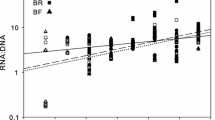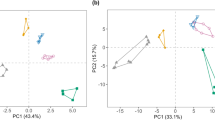Abstract
Replicated groups of Atlantic cod were rearedfor up to 40 days in 100 l tanks stocked at adensity of 75 eggs l−1. Larvae weretransferred from rotifers, Brachionusplicatilis, to either fresh-hatched orenriched Artemia nauplii on each of days5, 15 and 25 post-hatch (ph). Rotifers wereprogressively withdrawn over a 5 day period.The type of Artemia offered(fresh-hatched, enriched) did not affectsurvival or growth rates at any of the 3transfer ages. Larvae transferred toArtemia from day 5 ph suffered a highincidence of swimbladder over-inflation andhigh mortality during metamorphosis (< 1%survival to day 36 ph). Cod in the day 15 and day25 transfer groups did not differ significantlyin weight-specific growth rate or size on day40 ph (mean standard length 13.8 mm, dry weight3.8 mg). Highest mean survival rates to day 40ph (18.1%) and lowest mortality followingtransfer to nursery tanks were also observed inthe day 25 transfer groups. Fish that receivedArtemia from day 5 ph containedcirca twice as much total lipid per unit bodyweight and had a 30% higher triacylglycerol(TAG) content compared to all other groups.Ratios of the essential fatty acidsdocosahexaenoic acid (DHA), eicosapentaenoicacid (EPA) and arachidonic acid (ARA) alsodiffered according to age-at-transition.DHA:EPA ratio exceeded 1 only in codtransferred to Artemia on day 25 ph.Based on these findings, it is recommended thatintensively reared Atlantic cod should continueto receive rotifers until completion ofmetamorphosis.
Similar content being viewed by others
References
Bagarinao T. and Kungvankij P. 1986. An incidence of swimbladder stress syndrome in hatchery-reared sea bass (Lates calcarifer) larvae. Aquaculture 51: 181–188.
Baskerville-Bridges B. and Kling L.J. 2000a. Larval culture of Atlantic cod (Gadus morhua) at high stocking densities. Aquaculture 181: 61–69.
Baskerville-Bridges B. and Kling L.J. 2000b. Early weaning of Atlantic cod (Gadus morhua) larvae onto a microparticulate diet. Aquaculture 189: 109–117.
Crespo S., Marin de Mateo M., Santamaria C.A., Sala R., Grau A. and Pastor E. 2001. Histopathological observations during larval rearing of common dentex Dentex dentex L. (Sparidae). Aquaculture 192: 121–132.
Howell B.R. 1984. The intensive rearing of juvenile cod, Gadus morhua L. In: E. Dahl, D.S. Danielssen, E. Moksness and P. Solemdal (eds), The Propogation of Cod Gadus morhua L., Vol. 1. Flødevigen Rapportser, pp. 657–675.
Izquierdo M.S., Socorro J., Arantzamendi L. and Hernández-Cruz C.M. 2000. Recent advances in lipid nutrition in fish larvae. Fish Physiology and Biochemistry 22: 97–107.
Johnson D.W. and Katavic I. 1984. Mortality, growth and swimbladder stress syndrome of sea bass (Dicentrarchus labrax) larvae under varied environmental conditions. Aquaculture 38: 67–78.
Kjørsvik E., Van der Meeren T., Kryvi H., Arnfinnson J. and Kvenseth P.G. 1991. Early development of the digestive tract of cod larvae, Gadus morhua L., during start-feeding and starvation. Journal of Fish Biology 38: 1–15.
Kolbeinshavn A. and Wallace J.C. 1985. Observations on swimbladder stress syndrome in Arctic charr (Salvelinus alpinus), induced by inadequate water depth. Aquaculture 46: 259–261.
van der Meeren T. and Naas K.E. 1997. Development of rearing techniques using large enclosed ecosystems in the mass production of marine fish fry. Reviews in Fisheries Science 5: 367–390.
van der Meeren T. and Jørstad K.E. 2001. Growth and survival of Arcto-Norwegian and coastal cod larvae (Gadus morhua L.) reared together in mesocosms under different light regimes. Aquaculture Research 32: 549–563.
Morrison C.M. 1993. Histology of the Atlantic cod, Gadus morhua: An atlas. Part four. Eleutheroembryo and larva. Canadian Special Publications of Fisheries and Aquatic Sciences 119: 504 pp.
Murray H., Casanova J., Leggiadro C., Gallant J., Douglas S. and Johnson S. 2001. Gene expression and biochemical activity of various digestive enzymes during larval development in Atlantic cod (Gadus morhua) and haddock (Melanogrammus aeglefinus). In: C.I. Hendry, G. Van Stappen, M. Wille and P. Sorgeloos (eds), Larvi 2001 Fish and Shell-fish Larviculture Symposium. European Aquaculture Society Special Publication No. 30, pp. 400–403.
Otterlei E., Nyhammer G., Folkvord A. and Stefansson S.O. 1999. Temperature-and size-dependent growth of larval and early juvenile Atlantic cod (Gadus morhua): A comparative study of Norwegian coastal cod and northeast Arctic cod. Canadian Journal of Fisheries and Aquatic Sciences 56: 2099–2111.
Padros F., Minkoff G., Sala R. and Crespo S. 1993. Histopathological events throughout the development of turbot. Journal of Comparative Pathology 109: 321–334.
Pedersen T. and Falk-Petersen I.B. 1992. Morphological changes during metamorphosis in cod (Gadus morhua L.), with particular reference to the development of the stomach and pyloric caeca. Journal of Fish Biology 41: 449–461.
Pickering A.D. 1998. Stress responses of farmed fish. In: K.D. Black and A.D. Pickering (eds), Biology of Farmed Fish. CRC Press LC, Boca Raton, Fl, pp. 222–255.
Puvanendran V. and Brown J.A. 1998. Effect of light intensity on the foraging and growth of Atlantic cod larvae: Interpopulation difference? Marine Ecology Progress Series 167: 207–214.
Puvanendran V. and Brown J.A. 1999. Foraging, growth and survival of Atlantic cod larvae reared in different prey concentrations. Aquaculture 175: 77–92.
Ricker W.E. 1958. Handbook of computations for biological statistics of fish populations. Bulletin of the Fisheries Research Board of Canada 119: 300 pp.
Rosenlund G., Meslo I., Rødsjø R. and Torp H. 1993. Large scale production of cod. In: H. Reinertsen, L.A. Dahle, L. Jørgensen and K. Tvinnereim (eds), Fish Farming Technology. A.A. Balkema, Rotterdam, pp. 141–146.
Sargent J., Bell G., McEvoy L., Tocher D. and Estevez A. 1999. Recent developments in the essential fatty acid nutrition of fish. Aquaculture 177: 191–199.
Shields R.J., Bell J.G., Luizi F.S., Gara B., Bromage N.R. and Sargent J.R. 1999. Natural copepods are superior to enriched Artemia nauplii as feed for halibut larvae (Hippoglossus hippoglossus) in terms of survival, pigmentation and retinal morphology: Relation to dietary essential fatty acids. Journal of Nutrition 129: 1186–1194.
Shields R.J. 2001. Larviculture of marine finfish in Europe. Aquaculture 200: 55–88.
Steinarsson A. and Bjørnsson B. 1999. The effects of temperature and size on growth and mortality of cod larvae. Journal of Fish Biology 55(supplement A): 100–109.
Zhao Y., Chen Y. and Brown J.A. 2001. Impacts of egg and larval size on survival and growth of Atlantic cod under different feeding conditions. Journal of Fish Biology 59: 569–581.
Author information
Authors and Affiliations
Corresponding author
Rights and permissions
About this article
Cite this article
Shields, R., Irwin, S., Smith, P. et al. Effects of diet transition regimen on survival, growth and lipid composition of intensively reared Atlantic cod, Gadus morhua, larvae. Aquaculture International 11, 119–130 (2003). https://doi.org/10.1023/A:1024120301031
Issue Date:
DOI: https://doi.org/10.1023/A:1024120301031




